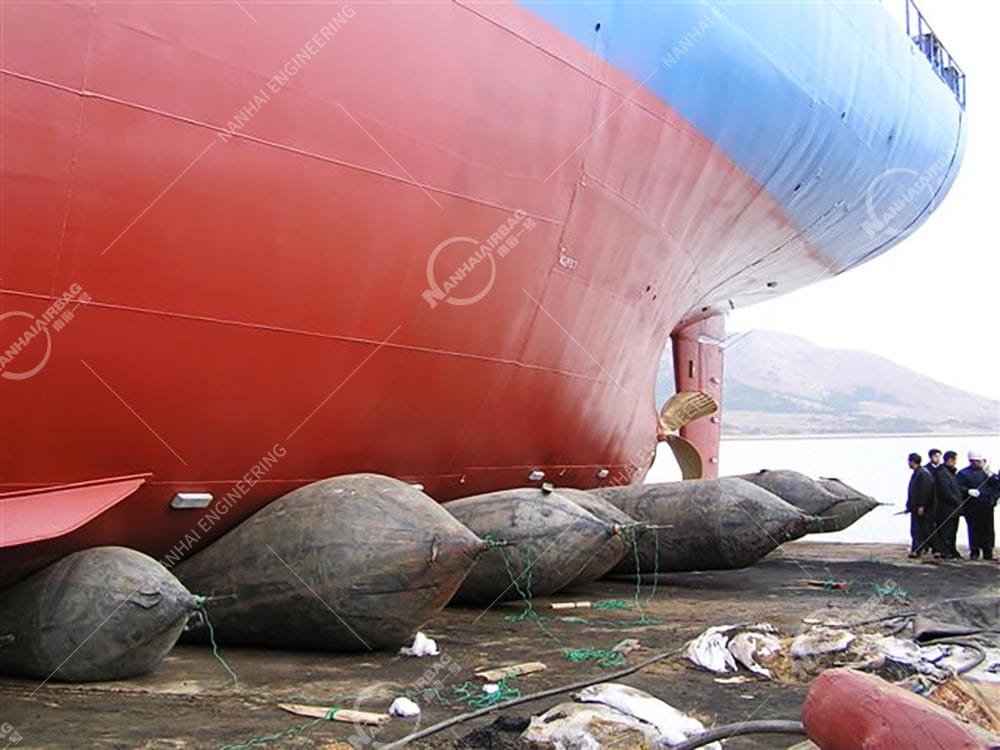How to ensure safe use of ship airbags
06/12/2025Precautions for Ship Launching Airbags
06/13/2025How to Place Ship Launching Airbags When in Use?
Why Does Airbag Placement Matter?
When launching a ship, every small detail matters—and airbag placement is one of the most important. A misaligned or poorly spaced airbag can cause the ship to tilt, slide unevenly, or even suffer structural damage. For example, a fishing boat launch in Southeast Asia once failed because the airbags were too far apart, causing one to burst under stress. This shows how the correct placement of ship launching airbags is critical for safety and success.

How to Properly Place Ship Launching Airbags
Place airbags in a single row beneath the hull whenever possible. The axial centerline of each airbag should be perpendicular to the moving direction of the ship. This ensures balanced force distribution and smooth movement.
The ends of the airbags (the heads) should not stick out too far from the ship sides. However, for vessels with a low block coefficient, like tugboats or fishing boats, the airbag ends must stick out on both sides. Each end should extend slightly more than the airbag diameter to provide better stability during movement.
For wide-beam ships, a double-row airbag setup is acceptable. If used, ensure there is at least 0.5 meters of space between the two rows.
Keep the working height of the airbags as low as possible during launching. This helps maintain ship stability and reduces the chance of airbag slippage or rolling errors.
During flat-surface movement, use winches at both the bow and stern to pull or release the ship in sync. When the ship reaches the slope, the stern winch can stop pulling—only the bow winch needs to continue releasing cable.
Common Mistakes to Avoid
- Misaligned airbags: This can cause uneven pressure and instability.
- Too much extension of the airbag ends: Creates a risk of tilting or losing control.
- Improper height: High working height increases stress and the chances of airbag failure.
- Skipping the use of guide airbags: Results in poor directional control.
Choose the Right Marine Rubber Airbags
When selecting ship airbags, always check:
- Material quality: Choose marine airbags made from reinforced natural rubber.
- Layer count: More layers mean stronger load capacity.
- Diameter and length: Match them with your ship’s dimensions and weight.
- Trusted suppliers: NANHAI offers custom marine rubber airbags tailored to your needs.
Final Tip: Professional Placement is Protection
Whether you’re launching a barge, ferry, tug, or fishing vessel, how you place your ship launching airbags is as important as the airbags themselves. If you’re unsure, don’t guess—contact us for technical advice and product recommendations.
People Also Ask (PAA)
How far apart should ship airbags be placed?
Ship airbags are typically spaced 0.8 to 1.2 meters apart, depending on the ship’s size and weight.
Can marine airbags be used on uneven ground?
It’s not recommended. The ground should be leveled and cleared to prevent airbag damage or improper rolling.
What’s the difference between marine rubber airbags and standard rubber airbags?
Marine rubber airbags are made for heavy-duty ship launching, featuring multiple layers and abrasion resistance, while standard rubber airbags are not built for marine use.
Is double-row airbag placement safe?
Yes, for wider ships. Just ensure there is at least 0.5m between rows to avoid compression overlap.
How do I control the direction during launching?
Use guide airbags and control the movement with bow and stern winches for precision.
